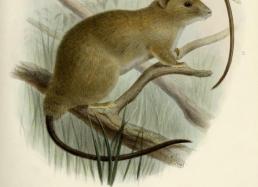3: Rediscovering an Amazing Rat
In my last dispatch, I left you hanging with the news that we may have discovered something very special, two days before our move to the upper part of the mountain. As it turns out, we were correct, and here’s the story of our fortunate find…
Danny Balete, one of our team members, had been setting traps in the patch of mature mossy forest he'd found. He'd been working especially hard at climbing up into the canopy to look for evidence of trails along the tops of the moss-and-epiphyte-covered limbs of the large trees.
In one of his carefully set traps, about five meters above ground, he caught a very special animal—the first specimen of Carpomys melanurus (the greater dwarf cloud rat) to be seen by any biologist since 1896! It's a beautiful animal (see above photo), with soft dense fur that is a soft orange-brown, as well as small rounded ears, large dark eyes, a long furry tail, and a short, broad snout.
With this specimen, including samples of its DNA, we'll be able to determine just how it's related to the many remarkable members of the cloud rat group, adding a crucial element to our understanding of the evolution of this highly distinctive group of mammals—a branch of the tree of life that is survives in the Philippines.
And more good news: we now feel confident that we know the type of habitat in which to look for this species in the future. Previously, we knew only that these rats were collected on a particular mountain (Mt. Data) in 1896 (see an 1898 illustration of this species below), but we now know they live in mature mossy forests that retain the large canopy trees, where little or no logging has taken place. This is a huge step forward in our ability to study the ecology of the species.
As you may imagine, the park supervisor and DENR office were absolutely delighted with the news about the discovery. We have already begun developing plans for a press conference at the end of the field season, at which the DENR and The Field Museum will jointly announce the rediscovery of Carpomys melanurus after 112 years, and will declare the greater dwarf cloud rat to be the new "conservation flagship species" for Mt. Pulag National Park.
In light of the devastating deforestation that Mt. Pulag has suffered, our hope is that the rediscovery of this amazing species will even more strongly motivate the public to promote preservation of the park’s unique cloud-forest habitat. If all goes well, our team will be able to train park staff in how to monitor wildlife, develop a set of information about natural history that will help to promote eco-tourism within the park, and provide a set of specific recommendations about how to reduce the damage done by vegetable farming.
All in all, we couldn’t ask for a more rewarding expedition, and I look forward to sending you more stories from the field as we head further up the mountain into areas that have never before been sampled.
More soon,
Larry





